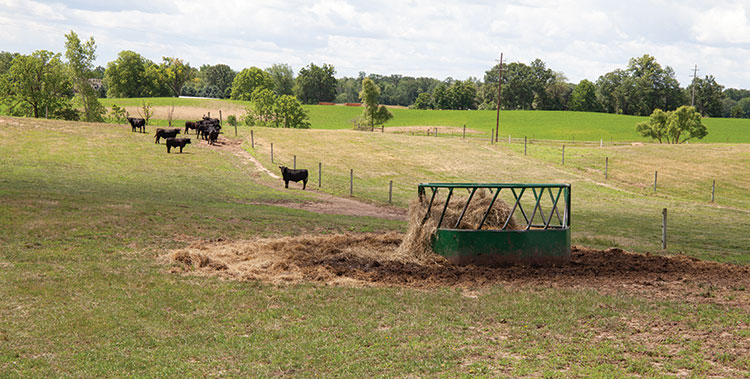
Current hay and forage inventories are approaching their annual low. This means there is a looming break from the daily feeding chores for some, but it also means there is the opportunity for improvements in feed storage facilities before the first cutting of hay or any silage is harvested. The benefit of improving storage facilities for forages, wet or dry, is not new. The primary goals of storage are to reduce waste, maintain quality, and prevent contamination. All of these factors are interrelated.
It’s intuitive for us to recognize that storing hay in a low area that can turn into a wet, muddy mess is a bad idea, but there are consequences less apparent than visible feed refusal and waste that impact animal health and performance. Contaminants come in many forms, including trash and manure. My “favorite” from last year was a ripe skunk in a hay bale. Some contaminants are unavoidable; others can be minimized and prevented by improving storage areas.
Depressed gains or other slight performance changes caused by spoiled or contaminated forages may or may not be noticed. For contaminants, health is often the most obvious and biggest concern. The skunk in the hay bale example seems humorous at a glance, but animal carcasses, even mice, pose a real risk of botulism. While some contamination can happen during harvest, additional health issues can arise from subpar storage environments.
Silage contaminated with soil is prone to causing health issues. Soil is often picked up during harvest, while packing, or when stored on an earthen floor. For example, soil is a good source of iron, which can tie up multiple minerals and lead to health problems. Manganese deficiency has been an issue for some producers recently.
A potential culprit is high-iron levels in corn silage, which can disrupt the absorption of manganese. In some cases, this can lead to calves being born with bull-dog-like features — a birth defect known as chondrodysplasia. Listeria is another disease often caused by poor, contaminated silage.
Waste not, want not
Feed waste may not be a line item in operating expenses, but limiting feed waste can be the most effective method of reducing feed costs. In addition to utilizing strategies to minimize feedout waste, if you’re putting in the work to make or source high-quality feed, storage loss needs to be minimized. Some dry matter (DM) loss from forages during the storage period is inevitable, but disregard for how forage is stored can result in losses of over 50% of the harvested DM.
Investing in feed storage is sometimes daunting, and the solutions most effective at reducing waste are the most expensive. Consider what makes the most sense for your operation based on resources, production scale, and environment.
Some basic low-cost strategies to reduce waste for dry forages might start with simply upgrading to a net wrap that is more effective at diverting moisture off bales, improving bale density, building a pad, or buying a tarp to cover bales. Remember, for 5-feet diameter round bales, the outside 9 inches make up 50% of the bale. Large round bales that are left uncovered and placed on the ground can result in feed waste of 5% to 61%, but in a well-drained area where bales are covered with plastic or a tarp, that range drops to 2% to 17%.
Cover up
In silage systems, even well-managed piles can experience DM loss around 15%. Simply covering a silage pit has a big impact, with uncovered piles resulting in losses of 24% to 58%. A Kansas study found that 10% of the silage DM was lost in just the top 10 inches in covered piles compared to a 75% loss when left uncovered.
Even before the characteristic dark layer of spoiled silage is visible, 5% to 20% DM loss can occur. Wisconsin data indicates silage bags and oxygen limiting tower silos are the most effective at reducing loss with a range of 6% to 17% in well-managed systems. Research demonstrates that each 1 pound per square foot improvement in bunker silo density saves an additional 1% of recovered DM simply by doing a better job of packing. Beyond just DM losses, declines in forage digestibility occur as well.
Significant DM losses can also occur at feedout. A concrete base will have less feedout waste compared to an earthen floor (3% to 5% compared to 8% to 20%, respectively).
Each operation is unique in its ability to justify forage storage infrastructure. There are a few tools available to compare hay storage options and how long it takes to recapture the investment, including the “Hay Storage Cost Comparison” spreadsheet from Iowa State University’s “Ag Decision Maker” website.
Any method to reduce waste needs to be in place before the forage harvest begins. Now is the time to run the numbers, make a plan, and initiate changes that will help boost your forage supply through the next feeding season.
This article appeared in the April/May 2021 issue of Hay & Forage Grower on page 13.
Not a subscriber? Click to get the print magazine.

